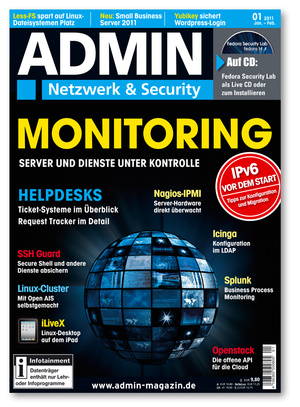 31 Jan – 4 Feb turned over the month with two articles in Admin Magazine, an Icinga appearance at the upcoming Chemnitz Linux Days and a FIAE apprenticeship offer.
31 Jan – 4 Feb turned over the month with two articles in Admin Magazine, an Icinga appearance at the upcoming Chemnitz Linux Days and a FIAE apprenticeship offer.
Rebecca started by sharing an article on Icinga published in Admin Magazine’s January-February edition. It covered presented the monitoring solution’s features including the recently integrated Business Process Addon and LDAP configuration enabler, LConf.
She went on to recommend another article on Request Tracker (RT) in the same Admin Magazine edition. Written by Julian Hein, it is a comprehensive guide to the open source ticketing system used to sort, and manage the processing of tasks and client enquiries in a structured manner. It covered RT’s many features and reporting capabilities with a “how-to” configure and automate custom processes also thrown in.
Julian then offered an event tip: Chemnitz Linux Days on 19 – 20 March will feature over 100 presentations and workshops, including one by Bernd Erk on “Icinga – Open Source Monitoring More Powerful Than Before”. Held at the Chemnitz University of Technology, the event also presents more than 50 open source projects in an exhibition area such as LibreOffice, Open Streetmap and a stand by the Icinga Team too.
Lastly, Marius called out to FIAE (Fachinformatiker – Anwendungsentwicklung) students looking for an apprenticeship in software development. From 1 September this year, a place will be open, offering practical experience in the latest web development technologies such as Python and PHP as well as low level/ data processing languages like C and Perl under Linux. Whether it be supporting consultants on client visits, maintaining or developing open source solutions, the apprenticeship will be highly varied and cover all areas of development – from conception to implementation, installation and configuration. Applicants are welcome to view the position details and apply online.
NETWAYS Blog
Artikel über das Open-Source Ticketsystem RT im Admin Magazin
„Nummern ziehen!“ lautet die Devise beim Einsatz des Ticketsystem „Request Tracker“ (RT). Der RT unterstützt Unternehmen bei der sinnvollen Verwaltung von Aufgaben, Kundenanfragen oder Work-Delegationen und hilft, diese durch ein nummerisches System sinnvoll zu sortieren und struktruiert zu bearbeiten. In der aktuellen Ausgabe des Admin Magazin geht Julian Hein im gleichnamigen Artikel „Nummern ziehen“ in verständlicher Form auf die vielfältigen Funktionen und Möglichkeiten zur Berichterstattung ein. Ebenso wird die Vorgehensweise zur individuellen Anpassung des RTs anschaulich erläutert: Der Script-Mechanismus erlaubt es, den RT und vor allem darin abgebildeten Prozesse sehr individuell zu konfigurieren und zu automatisieren.
Der RT unterstützt Unternehmen bei der sinnvollen Verwaltung von Aufgaben, Kundenanfragen oder Work-Delegationen und hilft, diese durch ein nummerisches System sinnvoll zu sortieren und struktruiert zu bearbeiten. In der aktuellen Ausgabe des Admin Magazin geht Julian Hein im gleichnamigen Artikel „Nummern ziehen“ in verständlicher Form auf die vielfältigen Funktionen und Möglichkeiten zur Berichterstattung ein. Ebenso wird die Vorgehensweise zur individuellen Anpassung des RTs anschaulich erläutert: Der Script-Mechanismus erlaubt es, den RT und vor allem darin abgebildeten Prozesse sehr individuell zu konfigurieren und zu automatisieren.
Einen genaueren Einblick können Sie im Artikel des Admin Magazines, Ausgabe Januar-Februar 2011 bekommen.
Weekly Snap: RT for mobiles, REST, Nagios Training and Jobs galore
 9-13 August offered two jobs, Nagios training courses, Request Tracker mobile interface and look into the REST architectural style.
9-13 August offered two jobs, Nagios training courses, Request Tracker mobile interface and look into the REST architectural style.
Julian tipped off a new mobile web interface for Request Tracker. The plugin automatically recognises the iPhone, Android and Blackberry, offering an optimised display of tickets and history. Tickets can be created and searched, attachments downloaded, and authenthication can be normal or external.
Karo was on the hunt for new colleagues to join the NETWAYS team, posting two positions – a Systems Engineer and a Developer. The Systems Engineer will join the Managed Services boys to implement and maintain internet platforms and independent projects, support customers on 1st and 2nd levels, prepare documentation and handover to customers. Of course all is based on open source and experience with Linux, MySQL, LVS, Heartbeat, DRBD is necessary. The Developer will have good knowledge of PHP and MVC frameworks, web technologies (HTML, AJAX, XML, XSLT and Java Script), Perl, and Object Oriented Perl, Eclipse GIT and Subversion, databanks (MySQL, PostgreSQL) and Linux systems and network technologies (Debian, Ubuntu). Applicants who enjoy customer contact and working on their own initiative are welcome to apply.
Bernd continued his development series on SOAP and REST with a look at the architecutural style of REST. As opposed to SOAP, Representational State Transfer offers an architectural model that is often found in the www,and a concrete method to deal with such interfaces. With the classic web commands- GET, POST, PUT and DELETE, developers can quickly and easily create applications, without needing to keep to defined transfer formats that SOAP requires. The decision lies however in the complexity and need for complex transactions to be bundled and routed. Most systems do come out nonetheless fine with REST and benefit from its simplicity.
Finally Manuela announced the latest dates for our Nagios training course for newbies. If you want to learn how Nagios works, how to configure it and monitor Windows and integrate SNMP based network components, keep the 6-9 September or 15-18 November free – or register with our „Blog 10%“ code to get 10% discount. Hope to see you there!
Wenig Prozessautomation in der IT
Viele Unternehmensprozesse – insbesondere in der IT – werden immer noch manuell ausgeführt und sind nicht automatisiert. Dabei ist den Verantwortlichen durchaus bewusst, dass Sie damit ein gewaltiges Einsparpotential verschenken, so die Ergebnisse einer kürzlich in der Computerwoche veröffentlichten Studie.
Nicht einmal jede zweite IT Abteilung verfügt über einen Automatisierungsgrad von mehr als 40% und nur jede siebte kann von sich behaupten mehr als 80% aller Prozesse automatisiert zu haben. Die wichtigsten Gründe für den geringen Automatisierungsgrad sind fehlende Mittel und die Befürchtung, dass entsprechende Projekte sehr aufwendig werden könnten. Dabei sind sich alle Beteiligten einig, dass durch die Automatisierung massive Einsparpotentiale freigelegt werden könnten. Knapp zwei Drittel alle IT-Manager erwarten konkrete Ersparnisse zwischen 11 und 20%.
In Wirklichkeit wird das Einsparpotential allerdings sogar noch höher liegen, denn es wird nicht nur unnötige Arbeit eingespart, sondern durch die Automatisierung werden außerdem Fehler vermieden. Da ein neuer Prozess ausgiebig getestet werden kann und danach automatisch abläuft kommt es zu wesentlich weniger manuellen Nacharbeiten bei Prozessfehlern.
Und auch die Angst vor den hohen Kosten und den langen Projektlaufzeiten ist unserer Meinung nach unbegründet. Auch im Open Source Bereich gibt es inzwischen sehr viele Tools mit denen sich IT Prozesse automatisieren lassen, wie beispielsweise Request Tracker (Service Management), Puppet (Configuration Management) und Mule ESB (Enterprise Service Bus) um auch komplizierte und systemübergreifende Prozesse ohne Lizenzgebühren zu implementieren.
(Quelle: OGiTiX Software AG, Computerwoche 29-30/2010)

Weekly Snap: OSDC countdown, RT in Computerwoche, Nagios Community Workshop and Icinga
 31 May – 4 June started the new month with speeches and articles galore. From the OSDC 2010 to the Nagios Community Workshop and Computerwoche, Julian took a look back and Manuela a look forward.
31 May – 4 June started the new month with speeches and articles galore. From the OSDC 2010 to the Nagios Community Workshop and Computerwoche, Julian took a look back and Manuela a look forward.
Manuela started the countdown to the Open Source Data Center Conference 2010 on 23 – 24 June. Amongst folding folders, she got keyed up about speeches from Jens Mücke of XING, on “Growing in Web Environments”, Dr. Hendrik Schöttle of Osborne / Clarke on “Legal Pitfalls in the Data Center – Data Privacy, Content Liability, Spam and Email Filtering” and hands-on workshops by Volker Lendecke (Active Directory with Samba4) and Jens Link (IPv6). A few places a still up for grabs so get in quick.
Continuing with events, Julian reported from the Nagios Community Workshop hosted by Nagios-Portal which was held this year in Nuremberg at qSkills. Thanks to its proximity, a good bunch of our team could be there to enjoy the interesting speeches that went beyond standard Nagios monitoring. Shinken, Merlin, LiveStatus, jmx4perl and even Bernd made an appearance with a speech on the latest developments in Icinga.
There he shared the most recent highlights including Icinga’s translation project into 20+ languages, it comprehensive docs and dynamic web interface. Of most note, Bernd announced Icinga Reporting for the first time. Through the integration of Jasper Reporting libraries, Icinga can generate reports quickly for all supported databases – MySQL, PostgreSQL and Oracle. The files are already available in the Icinga Git repository, and will be integrated into the new web interface with docs in the coming weeks.
Finally, Julian shared a bit of the limelight too, announcing his short article on Request Tracker recently published in Computerwoche. Beyond the usual little helpers that are usually introduced in the Cool Tools column, Request Tracker enables a complete, ITIL compatible helpdesk to be set up. Have a read here.
















